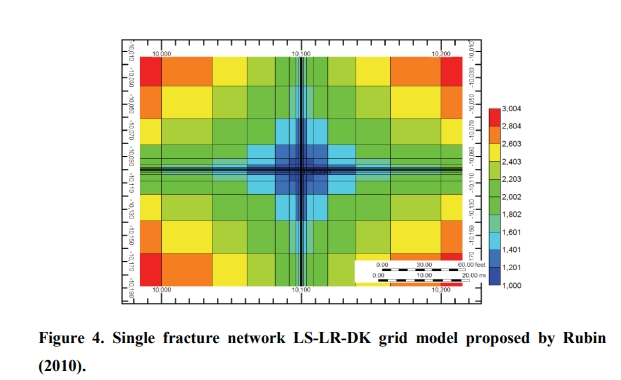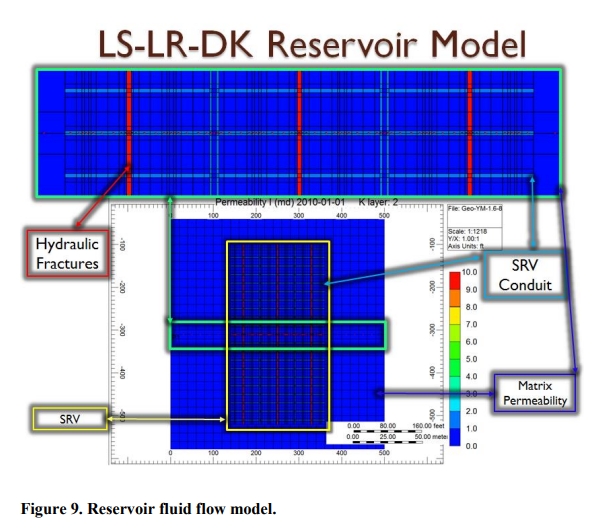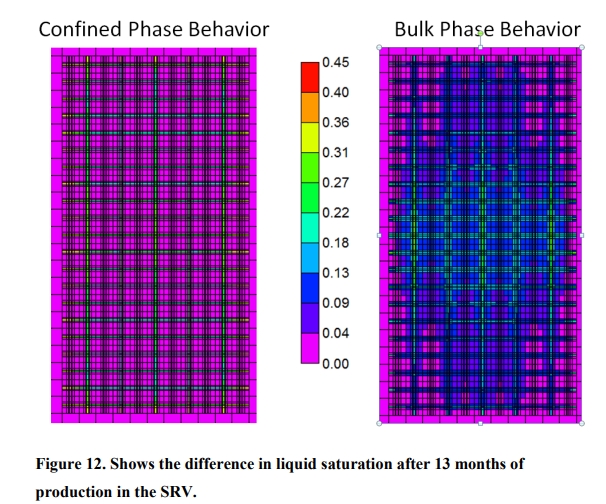在围压和渗透率作为孔隙大小函数的条件下地质力学及相态变化对非常规油气开发效果的影响
INTEGRATING EFFECTS OF GEOMECHANICS, PHASE BEHAVIOR UNDER CONFINEMENT AND PERMEABLITY AS A FUNCTION OF PORE SIZE ON GAS AND CONDENSATE PRODUCTION FROM UNCONVENTIONAL RESOURCES
在商业模拟器中模拟天然裂缝页岩气凝析液储层的生产面临许多挑战。相行为和地质力学不能轻易地被整合,并且对凝析液和气体生产有不同的影响。在创建储层模型时必须仔细考虑这些机制背后的物理原理。由于孔隙空间受限,相行为的变化可能对生产产生重大影响,这可以通过较大的孔隙空间和裂缝中的凝析液滴落来观察。地质力学在准确估计储层生产方面也起着重要作用。地质力学对储层岩石变形的影响可以通过抑制露点压力并允许在井的生命周期内生产更多的凝析液来观察。整合天然裂缝的闭合会导致凝析液产量的减少。
为了更好地理解这些机制,本文在组分建模软件中开发了一个气凝析液页岩储层模型,该模型整合了在纳米尺度限制下传输性质和相行为的变化。地质力学模型与储层流体流动模型进行了迭代耦合,以研究其对凝析液生产的影响。理解凝析液生产的机制将改善储层开发的优化。
CMG软件应用情况
在这项研究中,使用了CMG的GEM组分和非常规储层模拟器版本2013。该软件用于执行复杂的地质力学和储层流体流动模拟,包括迭代耦合地质力学模型和储层流体流动模型。软件还用于考虑孔隙尺寸限制对相行为的影响,并修改了状态方程以适应孔隙尺寸对纯组分的临界性质(Tc和Pc)的影响。



Abstract
Modeling production in a naturally fractured shale gas condensate reservoir that has been stimulated in commercial simulators faces many challenges. Phase behavior and geomechanics cannot be easily incorporated and have varying effects on condensate and gas production. The physics behind these mechanisms must be carefully considered when creating the reservoir model. Phase behavior changes due to confined pore space can have a significant effect on the production which can be seen due to condensate drop out in the larger pore spaces and fractures. Geomechanics play an important role in accurately estimating the production of the reservoir as well. The effect of geomechanics on the deformation of the reservoir rock can be seen by suppressing the dew point pressure and allowing more condensates to be produced during the life of the well. Incorporating closure of the natural fractures results in a decrease in condensate production.
To better understand these mechanisms, a model of a gas condensate shale reservoir incorporating the changes in transport properties and phase behavior within nanoscale confinement was developed in compositional modeling software. A geomechanical model was iteratively coupled with the reservoir fluid flow model to investigate the impact on condensate production. Understanding the mechanisms behind condensate production will improve optimization reservoir development.
The reservoir model was created using coarse, logarithmically spaced, locally refined, dual permeability (LS-LR-DK) within the stimulated reservoir volume (SRV) and unrefined dual permeability model in the unstimulated reservoir volume (USRV). The model represents a 1-stage hydraulically fractured well with 80 ft. cluster spacing. The reservoir and dew point pressures are 5,000 and 3,800 psia respectively. The reservoir fluid composition consists of 80% light (C1-C3), 10% intermediate (C4-C6) and 10% heavy (C7+) components. The reservoir temperature is 180°F. The matrix and natural fracture permeability were 149 nD and 1 µD respectively. The effect of confinement on phase behavior is considered by changing the critical properties (Tc and Pc) of pure components according to the correlations developed by Yixin et al.(2014).
The geomechanical model incorporated the model developed by Tran et al. (2002) in order to account for porosity changes as a function of pressure, temperature and total mean stress. Matrix permeability of the USRV and SRV were modified as a function of change in mean effective stress. The natural fracture permeability changes were calculated as a function of pore pressure change. Initial values for Poisson’s ratio and Young Modulus were 0.25 and 2.6e6 psi respectively. A value of 0.75 was used for Biot’s coefficient.
The condensate production was analyzed over a 15 year time frame. Confined phase behavior of the fluid resulted in a 10.6% decrease in cumulative condensate production when compared to bulk phase behavior. The confined phase behavior of the fluids caused more fluids to drop out inside the hydraulic fractures impeding the amount of liquid production. Poisson’s ratio increased from 0.15 to 0.35 resulted in a 1.4% decrease in cumulative condensate production. Young’s modulus increased from 1.6e6 to 3.6e6 psi resulted in a 1.5% decrease in cumulative condensate production. The less the reservoir rock would compact reduced the amount of condensate production. Matrix and natural fracture permeability decreased by 50% of their original values, as pore pressure decreased from 5000 to 2000 psi, resulted in a 1.2% production increase and 2.8% production decrease respectively in cumulative condensate production.
Not accounting for confined phase behavior and geomechanics can result in up to 12% variation in of cumulative condensate production estimations. Incorporating confined phase behavior results in liquid loading of the reservoir and impedes condensate production. Geomechanics related to rock deformation allow the system to more accurately predict production as pore pressure is maintained for a longer duration of time. The natural fractures provide conduits from the unstimulated area of the reservoir and significantly impact the estimations of hydrocarbon production. Understanding the interaction of fluids and reservoir rock during production will lead to improved reservoir development and simulation.
作者单位
俄克拉荷马大学研究生院 天然气工程与管理硕士 吉恩·马斯克(Gene Mask)

